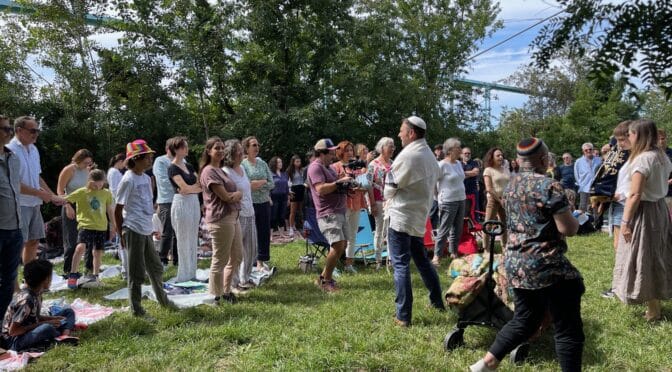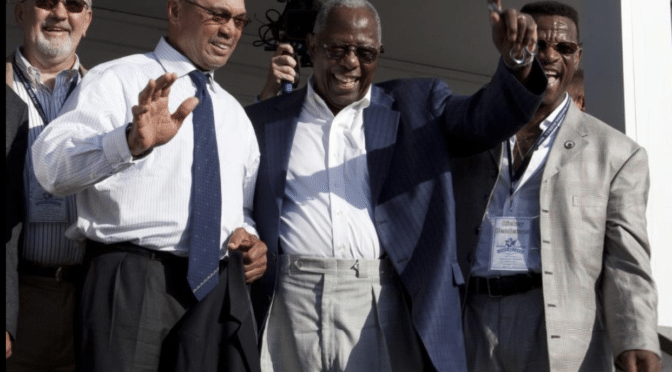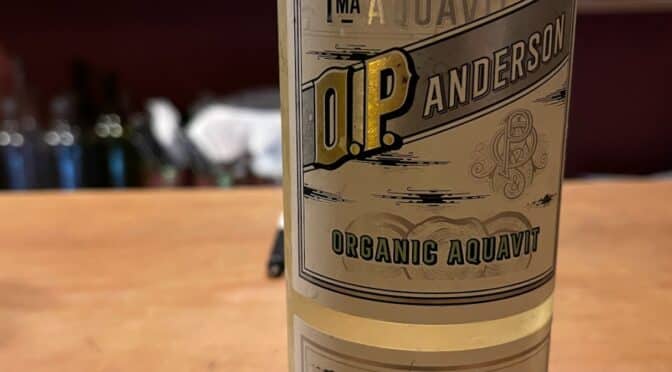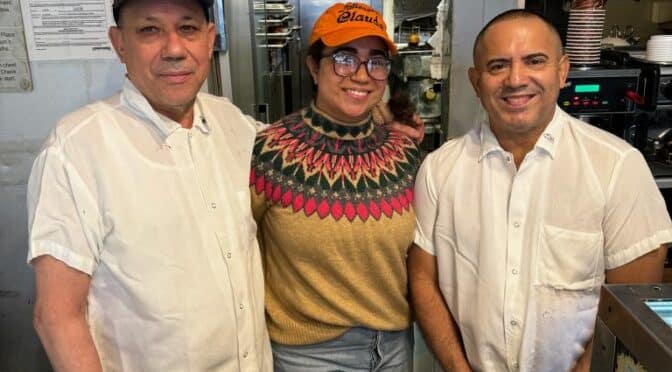When the traffic bottled up at Broadway and Prince, I thought about turning around and driving back to the garage. But my rational self reminded me that Jewish holiday services make me feel a happy connection with faith, tradition, and the sense of Jewish renewal. Keep going.
Still, I felt cranky and slightly resentful about this trip to Pier Six in Brooklyn Bridge Park for a Rosh Hashanah morning service. Why couldn’t it be in a building a short walk from my Manhattan home? Why Brooklyn? Yes. I know, you’re not supposed to drive on the Jewish holiday and especially on the sabbath. But this was Saturday morning and driving was the fastest way to get to there.
Thirty minutes later, I pulled into an expensive parking garage and walked down the park path past the restaurant and the restrooms. A little walk away, I found the clearing near the river and the volley ball courts where Rabbi Misha Shulman had gathered the New Shul group. The cool, crisp weather and bright sky felt like a blessing.
The New Shul has held Rosh Hashanah morning service outdoors in a park since the pandemic. The group has been unusual in a creative way since it started. Two friends, composer and lyricist Holly Gewandter and the performer Ellen Gould, founded it in 1999. They hoped to bring people together for Jewish celebrations, to study and incorporate music, art and creativity in the worship service. Many of the originals were from Greenwich Village and the Upper West Side. It has never had a building, but it has used the Village Community School for High Holiday services and other venues for Shabbat services.
Other rabbis have led the group and tapped into the spirit. I’m not a joiner, but did become a member when the musician-rabbi Zach Fredman used his enormous creativity and energy to attract new people. When he left, I stayed on because of Misha’s intelligence and the power of his deep Jewish belief that he generously shared.
“Who believes in God?” he asked at a holiday service last year. He raised his hand. So did I. Few others in the room at the time did.
But God or no god, Judaism is a fundamental part of me. The rise of anti-semitism in the United States and the world has made me feel that it is more important than ever to belong to a Jewish community of some sort.
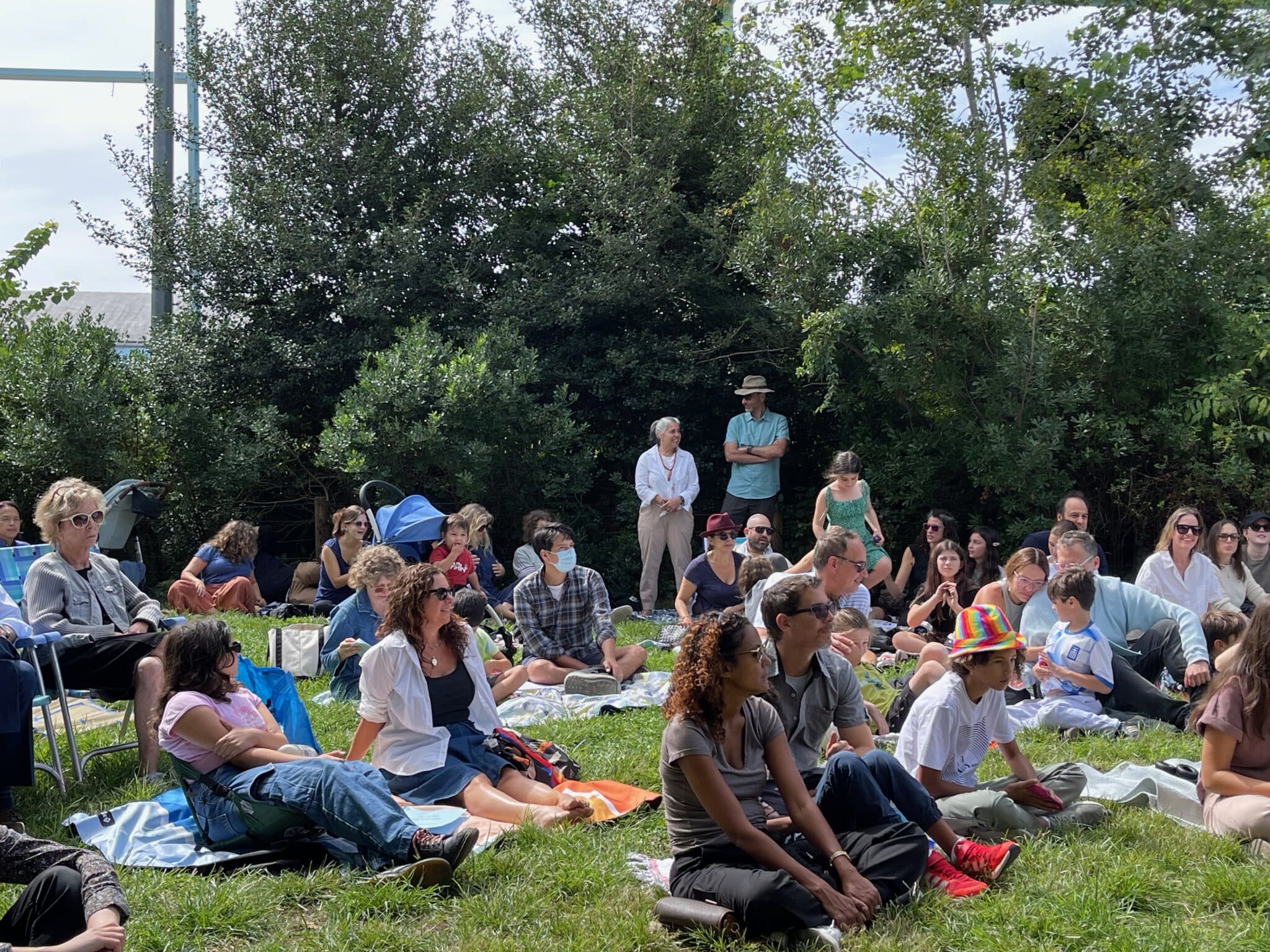
So here I was in the clearing looking at the people who sat on blankets and tablecloths in family groups, children and parents and grandparents, in a sprawling semi-circle facing Rabbi Misha. Others sat low in folding chairs and still others stood against the tree line. A little girl in a blue dress with stars and flouncy tulle wandered in and out of groups close to the rabbi. I was late and the praying had begun.
“Hallelujah. Hallelujah,” voices sang.
“Who likes to dance? You like to dance, come up,” the rabbi called out.
Three women answered the call and joined Daphna Mora, a singer and musician who urged others to join them.
I reached into the box that had held the prayer books. None left. I tried to make a place for myself on the ground and my body objected. My stiff hip and lower back wouldn’t allow me to get comfortable. I pushed to all fours to get up and made eye contact with no one.
Behind the rabbi, trumpet virtuoso Frank London, guitarist Yonatan Gutfeld, drummer Yuval Lion, and singer Dana Hertz guided the dancers with rhythm and melody.
“Ai Di Di Di Dai,” people chanted, swaying even as they sat.
I spotted a metal railing along the edge of the trees behind the rabbi. “Ai Di Di Di Dai.” I sat down and thorny branches of a rose bush on my left grabbed me, another branch on the right snagged the woven fibers on my jacket. I tried to shrug myself free. The more I moved the more I felt like an insect in a Venus fly trap. A younger woman saw me struggling.
“Oh, the thorns. Can I help? she asked. “Maybe,” I said and continued to try to disentangle myself. “I wonder what this means?” I said laughing and slipped out of my jacket so that I could pull free of the thorns.
“Bachu,” the rabbi said and called out a number in the machzor (prayer book).
I looked around to see if anyone near me had a prayer book that I could share. The younger women didn’t and everyone else seemed too engrossed or were already sharing.
A woman’s toe polish grabbed my attention. I saw a child lean back against his dad and my gaze went back to the white toe polish. Stop. Be here for the prayer, I chided myself, or go home.
“Sh’ma Yisraeil Adonai Eloheinu,” I tried to keep up with the others.
Then I remembered that Itamar Katz, the technical director, had sent the prayer book for download in case we wanted to Zoom. I found it in my phone and scrolled to the prayer.
“Everyone stand for the Amidah,” the rabbi said and he explained that we could read the words or pray silently. The Amidah is the central prayer of every service. You pray, you offer thanks and ask for forgiveness and you ask for something.
Silent prayer. I prayed to focus on prayer. I prayed to leave distraction and judgment behind. I prayed to be a better person.
The rabbi turned and pulled a cart covered with a torn patchwork quilt. The torah, usually housed in a structure called an ark, was snug beneath the quilt.
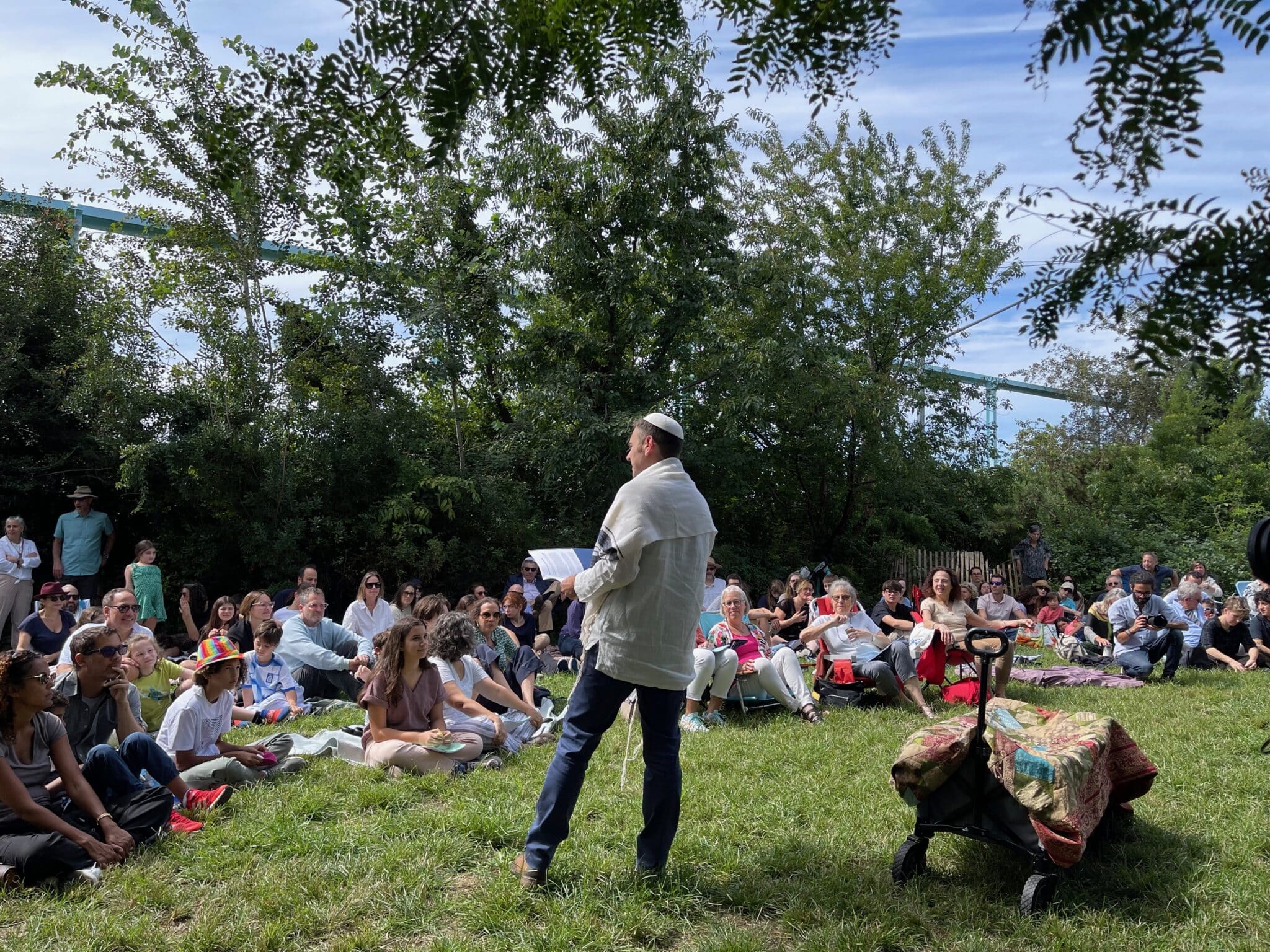
He followed the centuries old practice of offering honors and called a handsome family and several members of the congregation to participate in the torah ceremony. Like rabbis before him, Misha showed them how to remove the velvet cover and the bindings. An orange monarch butterfly flew low across the clearing toward the river. But the focus stayed on the torah.
Once they freed the torah from its bindings, the honored led a procession around the meadow so that everyone could touch it. I leaned in when they came close and took my turn. Something like a tiny electric shock pinged my psyche, I felt buoyant and stepped back smiling.
Maybe in that moment, maybe a second before, I really looked around at these people who could have been Jews in the desert 5783 years ago and understood that this coming together of Jews was just right, just a perfect way to bring Judaism to life right now.
And then I remembered something from the previous evening. Rabbi Misha had told a story on Erev Rosh Hashanah about Rabbi Nachman of Breslov, the great grandson of the Bal Shem Tov, founder of the Hasidic movement. Rabbi Nachman combined Kabbala mysticism with torah study. He also believed in using simple language to talk like a friend to god and made up parables and stories to bring Judaism closer to people. He and his followers formed a separate Hassidic sect, and other rabbis resented him and considered him strange.
In 1789 Rabbi Nachman traveled to Palestine in disguise and told his followers not to tell people he was there. He did other odd things. He walked barefoot. He didn’t go to Jerusalem. But he did look for new ways to approach prayer and devotion.
The point of the story didn’t make much sense to me when the rabbi told it. And a Rabbi Nachman parable that a congregant acted out made even less sense.
But in Brooklyn Bridge Park as the helicopters buzzed overhead and women read the torah, it became clear.
I listened closely to the Hebrew and the English translation of how Abraham followed God’s instructions and took Isaac up the mountain, bound him, and was ready to sacrifice him until an angel stopped him and told him to sacrifice a ram instead.
Before the reading, Rabbi Misha offered his interpretation. Abraham had faith and understood God would spare Isaac in the end. He also told the truth. So there is insight in the fact that he told his followers he and his son would both come down the mountain. His faith made it possible to face such a horrible act believing it would not have a horrible end.
The little girl in the princess blue dress with stars drifted among the torah readers. And the story about Rabbi Nachman grew clearer. Rabbi Nachman with his bare feet and stories and ability to connect with people was searching for something in Jewish worship that was down to earth, “. . . a new way that is ancient.” That fragment of his quote is posted on the New Shul website and it seems like it led us here.
We were a group of Jews in New York City finding our new Jewish way with ancient roots.
